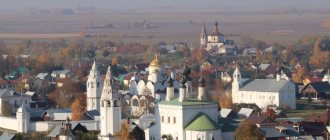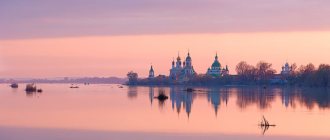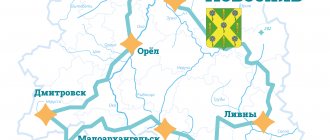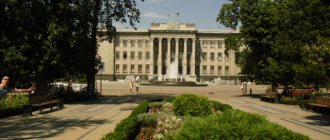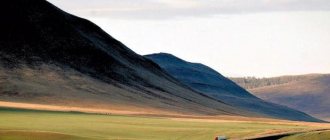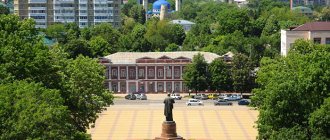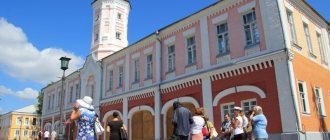Yaroslavl is an ancient Russian city, which bit by bit absorbs all the ancient monuments. The settlement appeared in the 6th century and today is the center of medieval architecture and cultural heritage of North-Eastern Rus'.
The settlement is characterized by a favorable location. There are road and rail connections. This is the most important transport hub of our country and a large federal district of the Russian Federation. The settlement is included in the UNESCO World Heritage List due to the presence of countless buildings from the 11th to 16th centuries.
Yaroslavl on the map of Russia
Yaroslavl belongs to the Central Federal District of Russia. It is located on the East European Plain, in its central part. The city is located on both banks of the Volga, in the place where the Kotorosl River flows into it. It is separated from the Russian capital by 282 km, and from St. Petersburg by almost 800 km. Yaroslavl is located northeast of Moscow, and southeast of the city on the Neva.
Yaroslavl is located in the same time zone as Moscow.
The city covers an area of just over 205 km2. Its average height is 100 m above sea level.
Yaroslavl is a transport hub from which roads and railway lines diverge in the direction of the Russian capital, Rybinsk, Vologda, Kostroma, Kirov, Ivanovo. The city also has an airport and a river port.
Yaroslavl is the third largest city in the Central Federal District of the Russian Federation by population. Only Moscow and Voronezh are ahead of him.
Administratively, Yaroslavl is divided into six districts: Leninsky, Dzerzhinsky, Kirovsky, Zavolzhsky, Krasnoperekopsky, Frunzensky.
Drama Theater named after Fyodor Volkov
The very first Russian theater, the Volkovsky Theater in Yaroslavl, celebrated its 260th anniversary in 2010. In those distant times, on the site of the modern theater there was a leather barn, in which Fyodor Volkov, the son of a merchant, began to hold the first theatrical performances. The first play performed was Esther, created by Rosin and translated by Volkov himself. The history of the theater includes many significant events; at the end of the 19th and beginning of the 20th century, the theater was already known throughout Russia. In 1911, the construction of a new building of the Volkovsky Theater was completed under the direction of architect Nikolai Spirin. This building can be seen in Yaroslavl today, it still houses one of the best theaters in Russia.
A little history
Yaroslavl is one of the oldest cities in Russia. There are several hypotheses for its foundation. Many of them proceed from the assumption that Yaroslavl was founded in 1010 by the Kyiv prince Yaroslav the Wise as a fortress located on the right bank of the Volga. Previously, there was an ancient Russian settlement in that place called “Bear Corner”. According to legend, Yaroslav surprised local residents by killing a bear, which they considered a sacred beast. The legend of this fight was subsequently reflected in the city’s coat of arms.
Flora and fauna
Yaroslavl has a fairly favorable climate, so the flora is quite rich; there are approximately 1,100 species of various flora representatives. Of these, approximately 250 species are rare, 9 species are listed in the Red Book of Russia.
These plants include:
- orchis orchis;
- Ophrys insectifera;
- leafless muzzle;
- wrestler Flerov;
- Liparis Lezel;
- Traunsteiner's fingerroot;
- lacustrine moss and bristly moss.
Due to the unfavorable environmental situation, stocks of some plant species have decreased: cranberries, blueberries, hazel, lily of the valley, valerian. Some representatives of the flora have completely disappeared forever: water chestnut, lady's slipper, Neottiantha capulata.
There is quite a lot of wetlands in the region (approximately 90 thousand hectares). Many rare plant species grow in the swamps, which have been preserved from the pre-glacial period. There are also new plants of pharmaceutical value: cordifolia, hopleaf raspberry, dropsy, etc.
Representatives of the animal world are mostly forest species. The fauna of the region is represented by small and large predatory animals, rodents, and lagomorphs. This composition of the animal world is characteristic of the southern taiga and deciduous forests.
In the lowlands you can find small rodents, bats, ducks, snipe, and gulls.
Of the birds, the most common are representatives of the order passerines, gallinaceae, and diurnal and nocturnal birds of prey.
Amphibians are also present here, of which there are about 10 species. A separate group of birds are species that live exclusively on water - there are about 70 species.
Representatives of mammals living in water bodies include the muskrat, water vole, shrew, and water shrew. Some of them (such as the water vole) are hunted for their fur.
There are few reptiles here due to the unfavorable climate for them; there are five species in total.
The forests are home to many mammals. Carnivorous mammals: lynx, bear, wolf, fox, raccoon dog, marten, badger, weasel.
Representatives of the rodent order: flying squirrel, mountain hare, common squirrel, various types of voles.
Also in the region you can meet representatives of the order Chiroptera (bats); they also belong to the inhabitants of the forest. This group of animals has been poorly studied to date; several species are found: noctule, dwarf pipistrelle, and leatherback.
In the forests of the Yaroslavl region you can meet ungulates: deer, roe deer, deer, wild boar, which comes running from the hunting grounds of the neighboring region.
Several protected areas of local importance have been established in the region. Under state protection are: squirrel, hare, elk, wild boar, black grouse, hazel grouse.
The region has a fishery fund, which consists of rivers, lakes, and ponds.
The inhabitants of natural reservoirs are:
- zander;
- bream;
- pike;
- burbot;
- ide;
- nelma;
- peled;
- grayling;
- carp, etc.
The following are grown in fish farms: grass carp, silver carp, and carp. The importance of these fish, in addition to their economic value, is the fight against waterlogging. There are many artificial reservoirs on the Volga River, which has caused changes in the hydrological regime. In this regard, migratory fish species have completely disappeared: sturgeon, stellate sturgeon, beluga, etc. Some new species are artificially introduced into reservoirs: peled, vendace, smelt.
The population of grayling and Pereslavl vendace are protected by the state.
How to get to Yaroslavl
The best way to get from the Russian capital to Yaroslavl is by train from the Yaroslavsky railway station. More than two hundred trains run through Yaroslavl, almost three dozen of them are branded. You will have to spend about four hours on the road.
You can get to Yaroslavl from Moscow by train. They also run from Yaroslavsky railway station. So, first you should get to Aleksandrov, then transfer to another train to Yaroslavl.
You can go by bus. In this case, the travel duration will be about six hours. Buses to Yaroslavl run from the Shchelkovskaya metro station, from the Central and Yaroslavl stations of the capital.
You can get from Moscow to Yaroslavl by car. From the capital there is the federal highway M-8 “Kholmogory”, along which you can get to your destination in four hours if there are no traffic jams leaving Moscow.
Planes fly from the capital to Yaroslavl. Travel time will be only one hour. Flights are operated by Sheremetyevo, Domodedovo and Vnukovo airports.
At least 10 trains run daily from St. Petersburg to Yaroslavl from Moskovsky Station. The duration of the trip will be more than 12 hours. There is a direct train from Ladozhsky Station once a day. Travel time will be almost 18 hours. You can also fly from the city on the Neva to Yaroslavl from Pulkovo by plane in a couple of hours. You can also go by car, but in this case you will have to spend at least 12-13 hours on the trip.
Religion
The vast majority of Yaroslavl residents (95%) are Orthodox Christians. The Yaroslavl diocese is one of the oldest in the Russian Orthodox Church. The region is rich in cathedrals and monasteries. It is not surprising that many pilgrimage tours are organized here. There are practically no representatives of other religions in the region.
The most famous monasteries and churches in the region:
- Assumption Cathedral;
- Church of Elijah the Prophet;
- Alexander Nevsky Chapel;
- Kazan Convent;
- Nikolo-Melnitskaya Church;
- Church of the Savior Not Made by Hands.
Poet Trefolev and the street named after him in Yaroslavl
There is Trefoleva Street on the map of Yaroslavl. In its name, the residents of Yaroslavl perpetuated the memory of their fellow countryman, the poet-democrat L.N. Trefoleve (1843-1905); the poet lived on this street. Trefolev was also a good translator, editor, and historian of his native land. The poet firmly believed in the wonderful tomorrow of his homeland. This is evidenced by the following lines from his pen: A cruel century, a cursed century, I will hardly survive, I will not see the wonderful twentieth century in reality. Thanks to their melodiousness and simple and figurative language, many of L. N. Trefolev’s poems turned into folk songs. These are, for example, “Dubinushka”, “Song about the Kamarinsky peasant” and “When I served as a coachman at the post office” (this was Trefolev’s poetic adaptation of the poem “Coachman” by the Polish poet Vladislav Syrokomli).
The first princes - Yaroslavl miracle workers
The first princely chambers and stone churches (Assumption and Spaso-Preobrazhensky Cathedrals) were built under the Rostov prince Konstantin Vsevolodovich
of Vsevolod the Big Nest
, known to us from the school curriculum .
Vsevolod, who had many children, divided the lands between his numerous heirs, and Konstantin, in addition to Rostov, got Yaroslavl, for the development of which he did a lot, very much ( early 13th century
).
Ancient Yaroslavl. Lithography
After the death of Konstantin, his son - Vsevolod Konstantinovich
, inherits the Yaroslavl lands, which under him become an independent appanage
Yaroslavl principality
.
Thus, Vsevolod in 1218
becomes
the first
Yaroslavl prince. He died in 1238 in another battle with the Mongol-Tatars, leaving behind two sons.
Vasily , would manage the principality for more than 10 years
, and after his death to Konstantin, the full namesake of his grandfather.
This next Konstantin Vsevolodovich
will die in the legendary battle with the Mongol-Tatars on Tugovaya Mountain
in 1257
. Both brothers found peace in the basement of the Assumption Cathedral in Rubleny Gorod.
The battle of Yaroslavl with the Mongol-Tatars on Tugovaya Mountain in 1257
The city and the entire principality reached unprecedented fantastic prosperity during the reign of the next Yaroslavl prince Fyodor Cherny.
(
late 13th century
), whose second wife was the daughter of the Khan of the Golden Horde, who converted to Orthodoxy. With her, he ruled the Yaroslavl principality, which during this period was not subject to devastating Mongol-Tatar raids, unlike their closest neighbors.
Fyodor Cherny provided protection for the principality from debilitating internal strife. His wife, baptized Anna, built Orthodox churches in the city, for which icons were painted. For example, the garrison Temple of the Archangel Michael
is the stone successor to the wooden church of the same name, built by Anna.
Stone Church of the Archangel Michael on the site of the former wooden one
Fyodor and Anna had two sons, David
and
Konstantin
.
Before his death, Fyodor himself became a monk and found peace in the Temple of the Entry of the Lord into Jerusalem,
attached to the Spassky Cathedral, and he was not buried in the ground, but simply covered with a veil. After the death of Feodor, David reigned for more than 20 years. Constantine never ruled the Yaroslavl principality, but legends say that he was distinguished by his kindness and humility.
After their death, both brothers were placed in the same way as their father in the crypt of the Spassky Cathedral, and also without burial. And this was at the beginning of the 14th century
. And then events developed very interestingly.
Temple of Yaroslavl Wonderworkers in the Spaso-Preobrazhensky Monastery
The last Yaroslavl prince who ruled in the mid- 15th century
,
Alexander Fedorovich
, voluntarily accepted the patronage of Moscow.
The Yaroslavl principality became part of the Moscow principality under Ivan the Third. This was in 1463
.
At the same time, Alexander Fedorovich raised the question of the burial of
Fyodor Cherny and his sons.
But when the coverings began to be removed from the deceased, inexplicable healings occurred. Fyodor and his sons were canonized and named Yaroslavl Wonderworkers
.
Fyodor Cherny with his sons - icon of the Yaroslavl Wonderworkers
the Temple of the Yaroslavl Wonderworkers was built especially for them
.
During the Soviet regime, their relics were displayed in the Elias Church for public viewing, and then they were kept in the Fedorov Cathedral Church
. Nowadays they are the shrine of the new Assumption Cathedral.
The sons of the first Yaroslavl ruler, Vasily and Konstantin Vsevolodovich,
.
In 1501,
the city was engulfed in another powerful fire, in the flames of which the city’s first stone churches, Spassky and Assumption, perished. So, while clearing away the rubble of the Assumption Cathedral, the relics of the second and third princes were found, who also turned out to be miraculous and were recognized as saints.
Images of Saints Basil and Constantine. Ancient embroidery
Thus, the first Yaroslavl princes, buried in the first city stone temple buildings, turned out to be miraculous during the discovery of their relics. This became an attractive moment for many believers who wanted to venerate such amazing Yaroslavl shrines
.
Climate
The climate of the city of Yaroslavl is moderate - continental, formed under the influence of the Atlantic Ocean. 150 days a year with temperatures below zero. 590 mm of precipitation falls per year. Most of them fall during the warm period. Winter in Yaroslavl is moderately cold and moderately snowy. It lasts for more than five months. The average January temperature is −11 °C, rarely dropping below 30 °C. There are thaws in winter. The average height of snow cover is 35 – 50 cm, sometimes up to 70 cm. Snow cover appears in the second half of November and persists for 140 days. Winds predominate from southern and western directions. The average wind speed is 4.2 m/s, sometimes more than 8 m/s. Summers are moderately warm and humid. The average July temperature is +18 °C, sometimes up to +37 °C
Popular message topics
- Acacia tree
Probably everyone is familiar with such a plant as acacia. It grows under our windows all year round, at the end of spring it begins to bloom, and then pods appear on the trees, very similar to peas. But besides that - Health-saving technologies
A mechanism that includes the action and connection of all circumstances in the field of childhood education at the time of development and learning. The range of health technologies includes the following types: - Buffoons
In Russia, traditions rarely went without fun, laughter and jokes. Therefore, the Russian people have always celebrated holidays widely, with songs, dances, and entertainment. This is where such merry fellows as buffoons appeared.
International forums for the city's millennium
International political forums were held in Yaroslavl from 2009 to 2011. In 2009, an international conference on the topic “Modern State and Global Security” was held in Yaroslavl.
In 2010, the forum “Modern State: Standards of Democracy and Criteria of Efficiency” was held in Yaroslavl. In 2011, the international forum “Modern State in the Age of Social Diversity” was held in Yaroslavl.
Yaroslavl is the most beautiful city in the Volga region, one of the few rapidly growing centers of our country that has retained a deeply individual appearance.
Articles about Yaroslavl
Churches of Yaroslavl Yaroslavl Kremlin Industry of Yaroslavl
Spaso - Transfiguration Monastery History of the city of Yaroslavl
Yaroslavl.Churches
Articles about Russian cities
Vladimir.Suzdal City of Derbent City of Tyumen
City of Tobolsk City of Novokuznetsk City of Salekhard City of Kideksha
